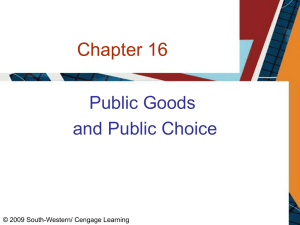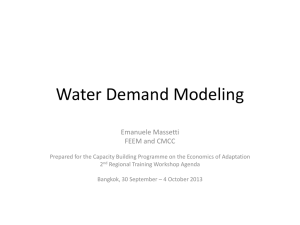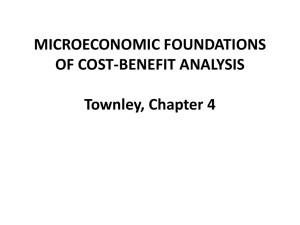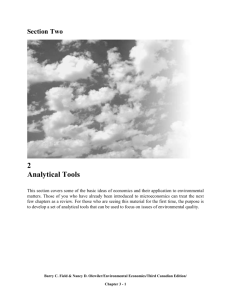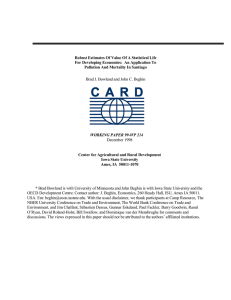Figure 3-1
advertisement
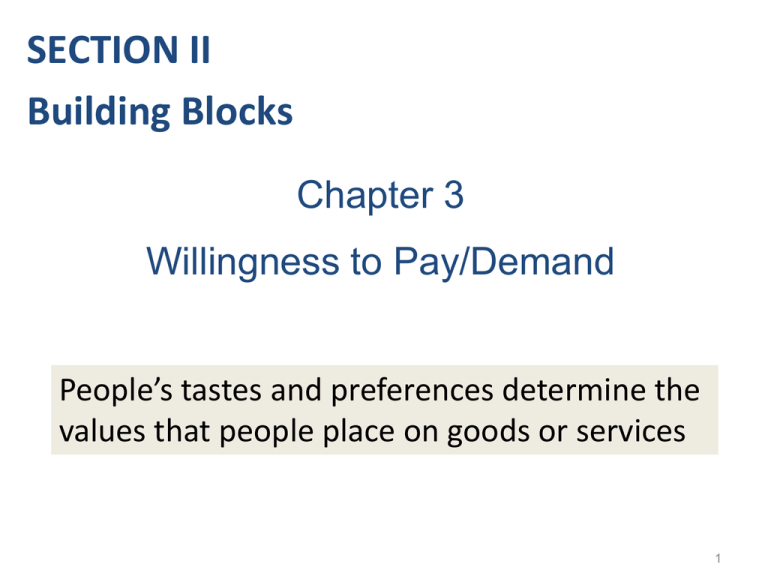
SECTION II Building Blocks Chapter 3 Willingness to Pay/Demand People’s tastes and preferences determine the values that people place on goods or services 1 1. Willingness to Pay (WTP) • The value a person places on a good or service is what they are willing to pay to get that good or service • Diminishing marginal WTP (MWTP): as the number of units consumed increases, the MWTP for each additional unit of that good goes down • Total WTP for a given consumption level: – the sum of the heights of the demand rectangles – the whole area under the marginal WTP curve from the origin up to the consumption quantity Page 43: Figure 3-1 2 MWTP and Demand • MWTP curve is demand curve • Figure 3-2, Panel (a) – Two D curves: one consumer, two goods; two consumers, the same good – The steeper D curve: MWTP drops off more rapidly as the quantity consumed increases • Figure 3-2, Panel (b) – Two D curves: two consumers (tastes, income…), the same good; one consumer (tastes, income…), the same good, at two different points in time – The D curve lying above: MWTP is higher for the same quantity 3 Aggregate MWTP/Demand Curve • Definition: the summing of the MWTP curves of all the individuals in the group of interest • For private goods: horizontal summing – Figure 3-3, page 47: at each price, the total amount consumed is a sum of the individual quantities consumed • For public goods: vertical summing – Figure 3-4, Table 3-1, page 48: at each quantity, the total MWTP is a sum of the MWTP of all individuals – A public good is one that when it is made available to one person, automatically becomes available to others as well 4 WTP and Benefits • “Benefits”: this word implies being made better off; flow from natural resource utilization and preservation • The benefits that people get from something are equal to the amount they are willing to pay for it – Because she values something, so she is willing to sacrifice, or willing to pay for it 5 • Figure 3-5, page 49 – The total benefits of increasing the availability of something from q1 to q2 = area b for the lower D curve, or area a+b for the higher D curve – Increase in quantity of q1 ‒ q2 would produce fewer benefits among lower-income people than among higher-income people – The higher D curve might be the demand for a biodiversity product after it is found to contain a promising pharmaceutical component; the lower D curve shows demand before this fact becomes known 6 WTP Over Time • Decisions made today, or this year, will have consequences in future years • Consumers are usually involved with streams of consumption over a series of periods • Figure 3-6, page 51: a sequence of willingnesses to pay for a sequence of quantities q0, q1, q2, q3 … • How can values of WTP occurring in different time periods be added together? 7 2. Discounting Compounding • If a sum of money (M) is put in a savings account at an interest rate of r, the value after one period of compounding is FV = M(1+r) • If M is left in the bank account for t periods, then the future value is FV = M(1+r)t 8 Discounting 9 T PV t 0 FVt (1 r ) t 10 Chapter 4 Costs/Supply Courses of action that are optimal for society clearly cannot be distinguished without taking both benefits (D) and costs (S) into account 11 1. Opportunity Cost • The opportunity costs of inputs (equipment, fuel, materials, crew… for commercial fishing) are the values they would have produced in their best alternative • Include “out-of-pocket” cash costs but are much wider than this – Input service provided by the fisher’s spouse – The environmental cost of a production process (pollution costs) 12 You are considering attending a concert. ECO 285-Ch 1 Ticket price: $35; cost of driving and parking: $20 In order to attend the concert, you will have to take time off from your part-time job (5 hours, $6/hour). Your opportunity cost of attending the concert = explicit cost + implicit cost = dollars actually paid out + value of something sacrificed when no direct payment is made = ($35 + $20) + ($6 x 5) = $85 When you spend $55 to buy a concert, you give up the opportunity of buying something else. When you spend 5 hours to attend a concert, you give up the opportunity of doing something else like your part-time job. 13 2. Cost Curves ∆TC MC = ∆Q • Marginal cost is the change in total cost resulting from a one-unit change in the quantity of output • Marginal cost works in both directions: – It is the added costs, the amount by which total costs increase when output is increased by one unit – It is the cost savings if production were to decrease by one unit • Figure 4-1, page 59: step-shaped; smooth • Total production costs: – The total area of the rectangles; the area under the marginal cost curve between the origin and the 14 quantity in question 3. The Shape of Cost Curves • Figure 4-2, page 60 • (a): short-run marginal cost curve – At low levels of output, the plant is not being fully utilized. As output increases, marginal cost declines – Increasing marginal costs: at higher output rates, the capacity is approached, marginal cost begins to rise • (b): long-run marginal cost curve (our focus) – Less curvature: marginal cost eventually increases but less steeply since there is time to expand the size of the plant – At larger output, marginal costs of the larger plant will be lower than those of the smaller plant 15 4. Social Costs • Refer to all the costs to society of a particular course of action • Figure 4-3, page 62: – a marginal social cost (MSC) curve for the protection of wildlife species diversity in a given geographical area – The out-of-pocket costs of the plan, the opportunity costs of the land uses, the damage costs… – At a 50% preservation level, the marginal cost is $p, the total costs is an amount equal to area a 16 5. Present Value of Cost • Resource development/protection programs normally extend over long periods of time, with costs being incurred each year throughout their life • Costs in the current period (C0) = the area under today’s marginal cost curve (MC0) up to today’s rate of output (q0) • Present value of a stream of costs: Figure 4-4, page 63 (r is the rate of discount) C1 C2 C3 Present value of costs = C0+ 1 r (1 r )2 (1 r )3 ... 17 6. Costs and Technological Change • Technological change normally makes production less costly • This shifts the marginal cost curve downward (as a result of the research and development that has gone into the technology): Figure 4-5, page 63 • The marginal cost of generating electricity from solar energy today is a fifth of what it was 25 years ago • There has also been major technical change in traditional fossil-based industries 18 7. Costs and Supply • Firms’ marginal cost functions are their supply functions • Aggregate supply function for an industry is the aggregation of all the individual firm’s marginal cost/supply curves 19 Ch3 HW Pages 54-55, Questions for Further Discussion: 1. Hint: are you willing to pay for what (use values and nonuse values)? 3. 5. 20 Ch4 HW Page 66, Questions for Further Discussion: 1. a. and c. a. The opportunity cost: a piece of land that is to be devoted to a public park The values that land could have produced had it been used for some other purpose, as well as the out-of-pocket costs of constructing and maintaining the park 4. 21

